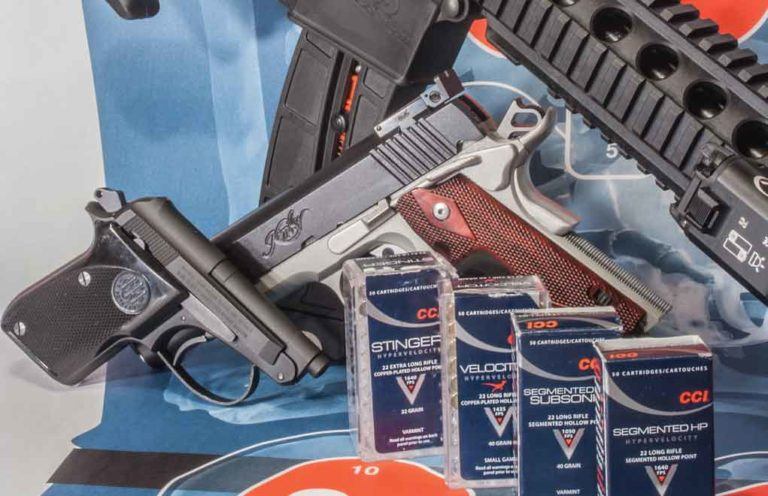
The .22 LR is among the most popular rounds ever devised. But is the rimfire a wise choice for self-defense?
Consideration concerning a self-defense .22 LR:
- To stop an attack, an assailant must change their mind or involuntarily surrender.
- Involuntary surrender is elicited in four ways: nervous system damage, structural damage, involuntary collapse and death.
- The .22 will most certainly cause pain, which can be decisive in stopping an attack.
- Given .22s are easier to shoot, they can deliver this pain multiple times.
- Most concealable guns, regardless of caliber, do not cause involuntary surrender.
- While it might not be the top choice, a .22 is better for self defense than no gun at all.
The gun you carry is really only a small part of an overall self-defense plan. It’s the gun guys who obsess over the type of gun you carry the most. Truth is, if you go about your life in the proper readiness condition, and exercise due caution when necessary, the chances of actually employing a gun in a self-defense situation are small. Even smaller is the need to actually shoot that gun once you introduce it into a situation. Still, when you really need a gun, nothing else will do … and a .22 LR is certainly better than no gun at all.

What we are concerned with here is if a gun chambered for the .22 Long Rifle is advisable or sufficient for life-saving duties. Most will immediately tell you it’s not. Some will allow its use for the elderly, poorly trained or those weak of arm and hand.
I’ve often thought this odd. If a .22 is good for those folks, how is it not good for everyone else? It’s kind of like the old deer rifle cliché where a lesser cartridge is considered allowable for kids or those of a small stature. Um … if a kid can use a rifle to kill a deer, shouldn’t a big ol’ boy be able to kill a deer with the same gun?
Let’s cut through all the preconceived notions and expert opinions and take an objective look at the .22 LR for personal protection from a pure ballistics standpoint. But first, let’s acknowledge the fact that just having a gun is sometimes enough. As a police officer, I responded to many calls where a citizen had pointed a gun at a bad guy, and that was all it took to thwart the attack. This proves that just having a gun might be more important than what type of gun it is, or even if it’s loaded.
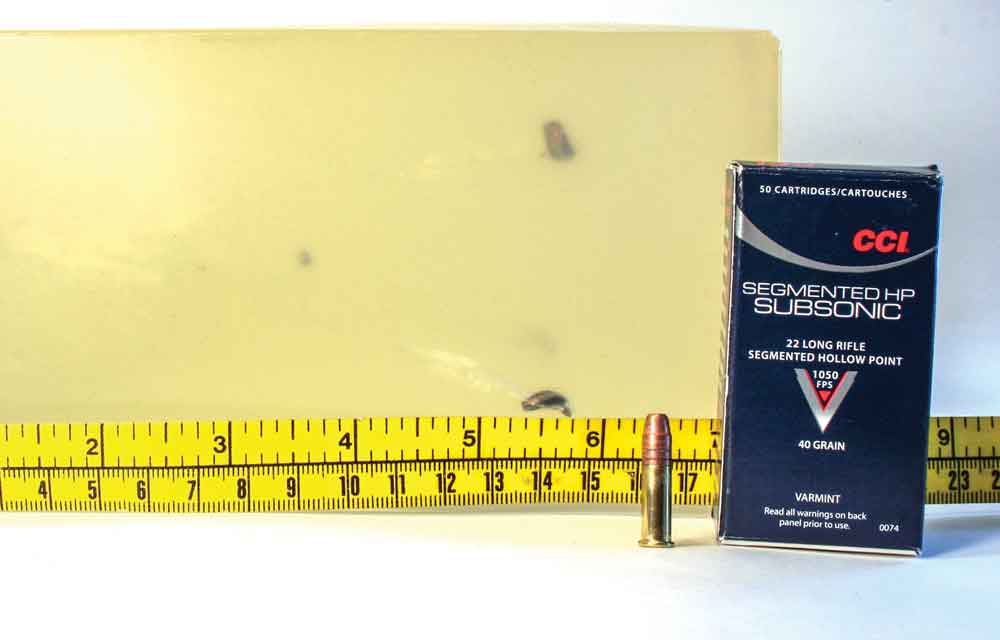
Don’t get me wrong, I’m not suggesting you use an unloaded gun to protect yourself; I’m just stating facts. Nobody likes to have a gun pointed at them, and fewer folks are willing to risk getting shot.
Thing is, however, you might have to shoot. Sometimes a shot fired — even if it hits nothing — is all that’s needed to stop an assault. Sometimes, when a bad guy gets hit — anywhere, with any bullet — that’s also enough to end hostilities. When we get down to whether your gun can instantly incapacitate a felon, we’re dealing with a last case and least likely, worst-case scenario.
The Four Fight Stoppers
Let’s consider the ways a bullet from a handgun can bring about instant incapacitation. Wounds that hurt can bring about voluntary surrender or, most often, a change of mind. But, what I’m talking about are wounds that bring about an involuntary physiological response. This can happen in one of four ways.
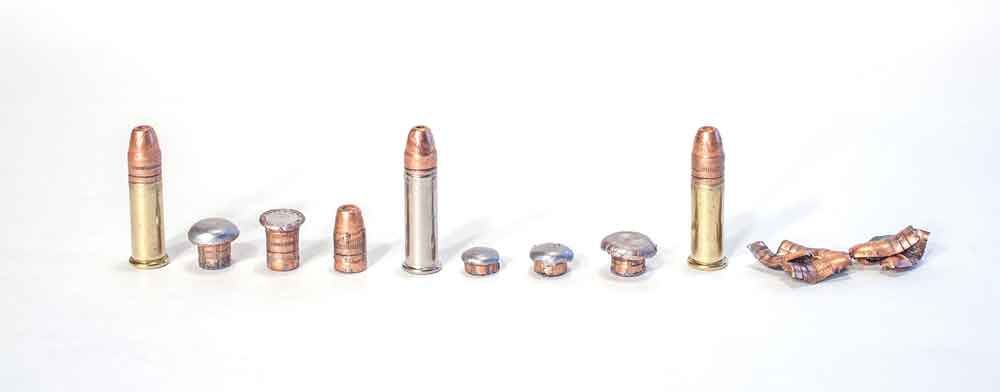
1. Damage to the central nervous system — a bullet to the brain — generally brings about instant collapse, and often death. No, not just a head shot; sometimes a headshot can lead to only superficial wounds.
2. Support structure damage will likely put a human on the ground. A bullet that breaks the pelvic support or severs the spine can put a fiend down either due to bone or nerve damage. But, just because they’re down doesn’t mean they’re not dangerous, especially if they have a gun, too.
3. Involuntary collapse might be the most hopeful outcome of a shot you place on an attacker. The problem is we don’t completely understand why involuntary collapse occurs. It could just be the body’s reaction to pain, a subconscious or neurological reaction. Either way, it’s unpredictable and not something to rely on.
4. Death. Death has a way of making bad guys permanently not bad anymore. Death from a bullet wound takes time. It has to cause hemorrhaging, and the body has to lose enough blood to deprive the brain of activity. On the short side, this could take maybe 10 to 20 seconds, on the long side, 10 to 20 minutes.
Getting The Job Done
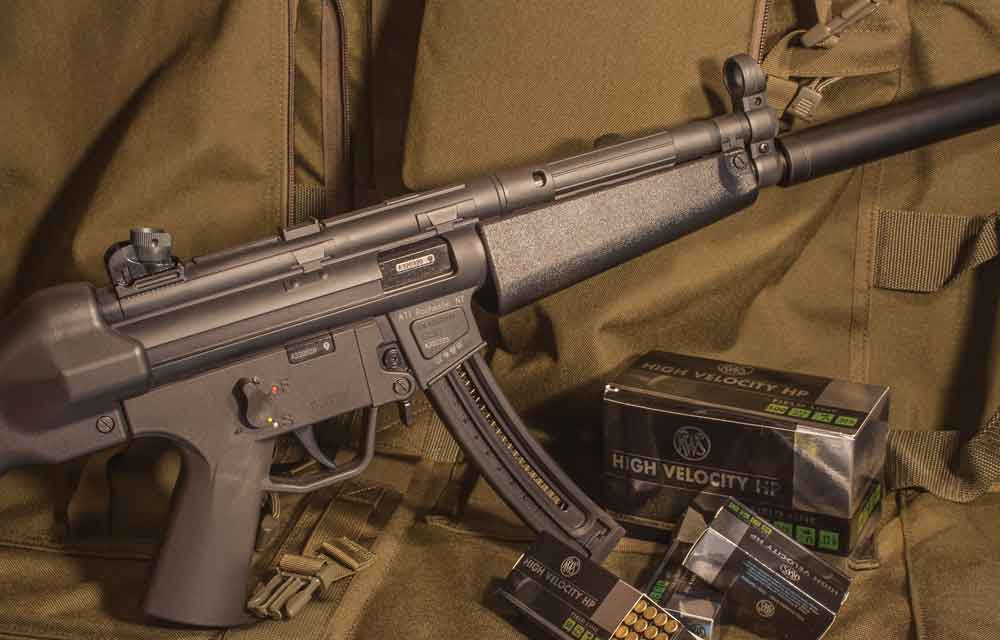
So the ballistic question is: How effective can a .22 LR be at causing one of these four reactions and ultimately saving your life? The FBI, in its infinite wisdom, specifies a bullet from a handgun should deliver at least 12 inches of penetration to be considered suitable for use by their field agents.
Can a .22 LR deliver 12 inches of penetration from a handgun or a rifle? I tested four different loads to find out. One of those four loads, the CCI 40-grain Velocitor hollow-point achieved that benchmark out of a rifle with a 16-inch barrel, and out of handguns with a 2.4- and a 5-inch barrel. Penetration depths were 14.5, 15 and 12 inches, respectively.
Another higher velocity load — the CCI Stinger — penetrated between 8 and 10 inches from the same firearms. CCI’s 32- and 40-grain segmented hollow-point loads only penetrated between 5 and 10 inches. However, the segmented hollow-point splits into three projectiles during penetration, so the wound cavity — though shallow — is three-pronged in its approach.
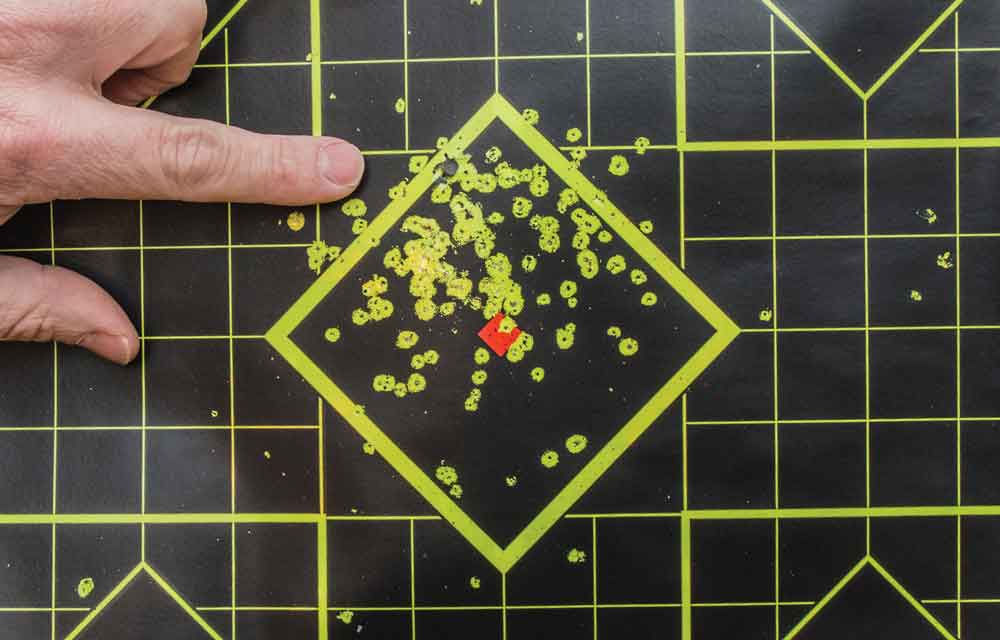
wound.
Essentially, if penetration is your goal, you’ll want to select medium- to high-velocity 40-grain bullets for the .22 Long Rifle. But, that might not be your best option, and/or you might have an aversion to potentially killing another human. After all, when you use a handgun to stop a violent attack, your goal is to stop the attack. Your desire to do anything beyond that would be considered with malice, and that has a way of sending folks to the big house — for a long time. That’s why devices such as pepper spray and stun guns are so popular, and they’re effective because they cause pain.
Imagine shooting an attacker in the face with a load of .22 shot from a handgun. At a distance of about 6 feet, this load, when applied to the eyes and smile of a goblin, has a very small chance of being lethal, but a very high chance of delivering a high dose of pain and temporary if not permanent blindness. Any of the three outcomes should suffice to bring about that change of mind or the involuntary surrender you’re looking for.
For that matter, imagine shooting an attacker in the face with any .22 LR load. It might not be the same as a bullet from a .357 Mag., but it will hurt. By golly it will hurt worse than a sting from a ball-faced hornet! Could that potentially make the bad guy even “badder” or madder? Yep, for sure. But, there are things outside of ballistics to consider.
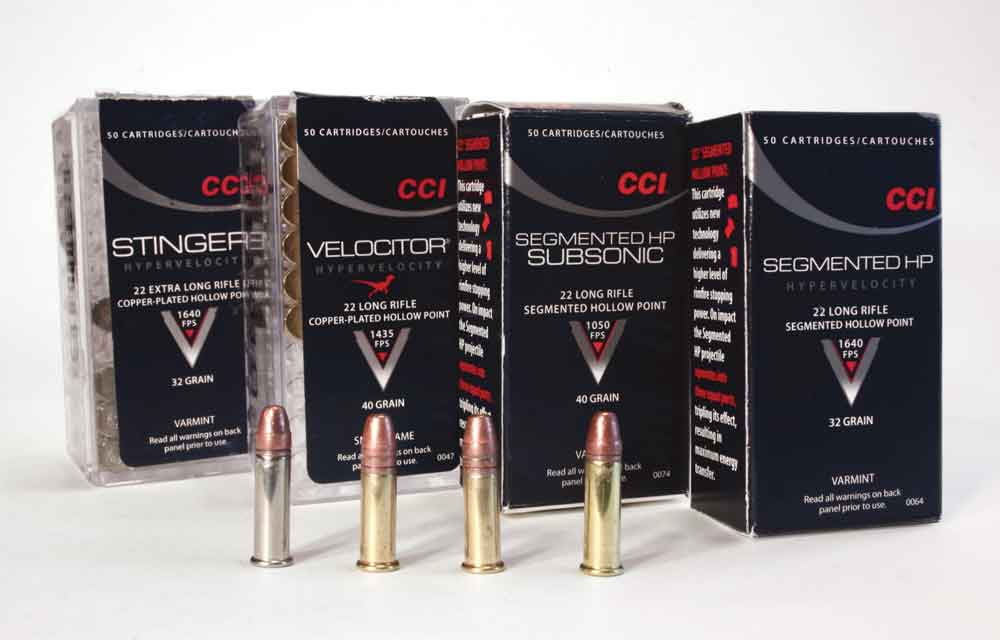
Handguns or rifles chambered for the .22 LR have almost non-existent recoil, and most people find them easier to shoot more accurately and faster. You can fire 10 accurate shots from a semi-automatic .22 pistol or rifle in about the same time you can fire five or six shots from a centerfire handgun or rifle. In other words, you could shoot a bad guy nearly twice as many times, in the same amount of time, using a .22 LR as you could with a 9mm handgun or rifle.
Parting Shots
So where does all of this leave us? With regard to defensive handguns most often carried for personal protection, they’re mostly pain delivery devices. In other words, your best bet when shooting a handgun to save your life is that it will cause enough pain to make the attacker stop attacking. It’s just a matter of ballistic fact that concealable handguns that can be comfortably carried long term, are just not that effective at causing instant incapacitation. They do, however, perform rather well when it comes to convincing someone to cease and desist hostilities.
A .22 Long Rifle handgun would not be my first choice when it comes to an every day carry, personal protection handgun. Your ability to inflict pain increases with caliber and is improved with the modern high-tech bullets now available for cartridges such as the .380, 9mm, .40 S&W and .45 Auto.
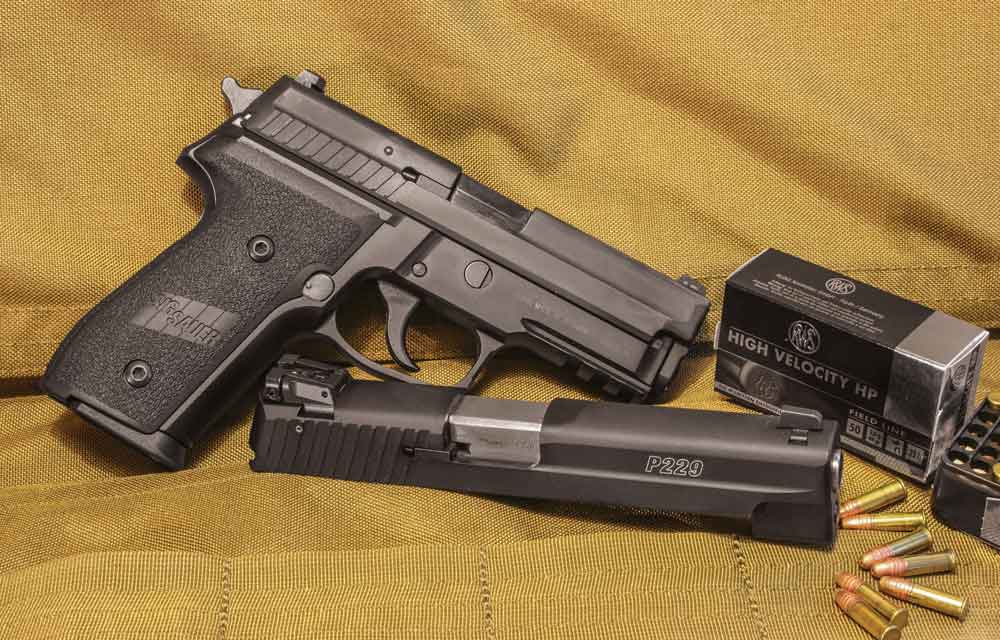
comfortable with a .22 LR
for self-defense, don’t
overlook how a rimfire
conversion kit, like this one
from Sig, can help you practice with your defensive handgun at a much-reduced cost.
At the same time, I’d rather have a .22 LR handgun for personal protection than I would a stun gun — which requires you to be very close — or pepper spray — which is a bit dependent on the wind blowing the right direction. After all, there’s a good chance when I point that .22 LR handgun at the bad guy, he’s going to do what most bad guys do when a gun gets pointed at a human, and that’s — at least momentarily — stop whatever they’re doing. Few things are a better attention getter.
Let me leave you with this food for thought: The gun in my closet is an S&W M&P15-22. It’s loaded with a full magazine of CCI Velocitors, has a compact reflex sight and a Crimson Trace light/laser combination fore-grip. Everyone in my home, from the 10-year-old up, can operate this little carbine. And, with it they’re capable of delivering accurate fire, at a fast pace, across any room in my house, and even out to the fence that surrounds it. (It’s also great for rabid foxes — we’ve had two at my house — and the raccoons that seem to think my garbage cans are their own personal buffet.)
A .22 LR might not be the best choice for personal protection, but that does not mean it cannot be a good one.
Find Your Next .22 Pistol:
- The Best .22 Pistols Available Today
- Ruger .22 Handgun: Gun Digest’s Top Pistol Picks
Editor's Note: This article originally appeared in the Concealed Carry 2018 issue of Gun Digest the Magazine.

Next Step: Get your FREE Printable Target Pack
Enhance your shooting precision with our 62 MOA Targets, perfect for rifles and handguns. Crafted in collaboration with Storm Tactical for accuracy and versatility.
Subscribe to the Gun Digest email newsletter and get your downloadable target pack sent straight to your inbox. Stay updated with the latest firearms info in the industry.

![Best Concealed Carry Guns In 2025 [Field Tested] Wilson Combat EDC X9S 1](https://gundigest.com/wp-content/uploads/Wilson-Combat-EDC-X9S-1-324x160.jpg)


![Best 9mm Carbine: Affordable PCCs [Tested] Ruger Carbine Shooting](https://gundigest.com/wp-content/uploads/Ruger-Carbine-Shooting-100x70.jpg)
![Best AR-15: Top Options Available Today [Field Tested] Harrington and Richardson PSA XM177E2 feature](https://gundigest.com/wp-content/uploads/Harrington-and-Richardson-PSA-XM177E2-feature-100x70.jpg)

I find it laughable when people debate stopping power. I’ve been shot twice with a .22LR. I don’t know of anybody that will continue to attack after 5 or more shots with a .22. I was down with two, one to my thigh and one to my hip. You do not want to be shot with a .22, let alone .32 or .380. Trust me on this. The burn is enough to stop most people unless they are on PCP, which the odds are against.
Don’t never think a .22 LR will not kill a human being. People died from a .22 cal. revolver head shot. Plus, with the right type of round, it has stopping power for most home intruders or parking lot attacks. You have to consider the internal organs and where fragments end up. Doctors would rather remove a single slug than several small fragments close to vital areas of the body.
Your false statement that “the internal damage they are capable of causing is minimal” re: .22 cal is incredibly, unbelievably stupid and dangerous. .22 is highly capable of inflicting absolutely lethal internal damage, especially at close range, and .22 in fact kills more people than any other caliber. This brain dead macho posturing about .22 being a “pee wee” round, by chowderhead self-declared ballistics “experts” is of course an internet staple, but we’ve got to take a stand against these dangerous lies. The internal organs of even the strongest person are incredibly delicate, complex, watery tissues, and are easily disrupted by even the smallest bit of supersonic high velocity metal. All firearms are absolutely lethal weapons, and should only be handled by skilled, trained, serious, sensible adults who fully understand and respect their inherent lethality. Sure, a 44 may be more thoroughly and reliably lethal than a 22, but there is no difference to the end recipient between being completely blown away by a 44, and just barely killed by a 22.
Only in the movies…
During the Moro rebellion, “Antonio Caspi, a prisoner on the island of Samar, P.I. attempted escape on Oct. 26, 1905. He was shot four times at close range in a hand-to-hand encounter by a .38 Colt’s revolver loaded with U.S. Army regulation ammunition,” Col. LaGarde wrote. “He was finally stunned by a blow on the forehead from the butt end of a Springfield carbine.” Keep in mind the 38 long colt loaded to military standards is about half again as powerful as the most radical 22 LR. Three rounds struck his chest and perforated his lungs. Of these three, one exited his body, another lodged near the back and the third lodged in subcutaneous tissue. The fourth round went through his right hand and exited his right forearm. Instances like these led to the conclusion that the .38 Long Colt simply didn’t have the power to effectively stop a threat. So, if a 38 Long Colt is weak, a 22 LR isn’t going to stop someone really out to do you harm. Oh, a 22 LR will kill someone alright but unless its a well-placed shot, it isn’t going to stop anyone. Around 1966 or so, a Kentucky state policeman shot a country guy coming after him with a knife. Hit him 5 times with a 357 and that didn’t stop him. The guy cut the state policeman and killed him. I don’t know if the guy died from his gunshot wounds or not. Ronald Reagan took a 22 LR shot under his armpit and into his chest cavity and didn’t even know he was shot. To stop someone, a 45 caliber works best so far. 45 ACP, 45 Colt, 454 Casull, and 460 Smith and Wesson will all stop someone in their tracks giving you time to shoot again if needed.
Good comments about “involuntary surrender”. So many people want to talk about the “one-shot take-down” when discussing self-defense firearms. The clear thing in those discussions is that whoever advocates for a “one-shot” takedown has never actually shot a person (or any good size animal for that matter).
Rarely will a gunshot instantly incapacitate somebody (or something). Ask any hunter. Yes, there is the one-shot kill for sure. But as you pointed out, that kill may take a while to reach its ultimate conclusion. It will almost always take enough time for a determined bad guy to start shooting back in an attempt to take you with him.
This is a very good article, without all of the caliber hype, and with a very good perspective on how psychology plays a bigger role in self-defense usage of guns than specific caliber does.
To conclude, a simple story demonstrating the truth of what you said. I had a bad guy block my path then jump out of his car and start to come after me. I simply reached into my glove box, pretended to take something out, then fixed a gaze on the guy that said “bring it on”. He stopped, hesitated for a moment, then turned around and left. I would have preferred to actually have a gun in hand, to back up my bluff — but the simple fact that I appeared to have a firearm was enough to end the situation.
I must comment.. that anything food wise does not go in my garbage.. I’ve not had any problems in forever with animals rummaging in my trash and throwing it all over the road.. All you need to do is throw the waste food out your back door and GIVE back to the natural environment which you were so well blessed with.. THE MAX
A shot to head won’t hurt it might just lay you for good case in point would be RFK. https://www.historicalfirearms.info/post/52226442432/the-gun-that-killed-rfk-22-caliber-iver-johnson
You (and the author) have to realize that the reason people advocate for a smaller gun for the young or the infirm is because that’s what they can handle, not because it’s the best choice for the job. Having said that, if you are in a situation where you can only handle a .22LR, then practice, train and become very proficient with it. People have been known to kill black bears with a .22 when they hit the brute in the eye. That takes practice, so practice.
I’m not advocating using a .22 LR round for self defense, but I think this guy is off if he thinks you shoot someone in the eye and it will only blind them. They would be dead. There is no skull at that point to penetrate so you are going straight into the brain with it. Furthermore, I have seen tests with shooting .22 in dead cow skulls and it penetrates it with no problem. I don’t think a human skull would be an issue for it. if it is in your brain, you are more than likely dead. If not dead, you are more than likely a vegetable and probably wish you had died.
He was referring to shooting someone in the face with .22LR “Shotshell” or “ratshot” rounds. They’re mainly used for what they are named after, shooting rats or other small rodents at close ranges. Think of it as a very small shotgun shell. At 6ft away, it’s going to really mess up your face cosmetically speaking, and will most likely cause temporary or permanent blindness while also inflicting quite a bit of pain. Probably would mess your teeth up pretty good too.
I have 2 9mm, and a .45. I also have a Taurus TX .22. 4 mags of 16 rounds is 64 rounds. And very light. While I normally carry one of the 9’s, at SD distance, 16 holes in someone ain’t no joke. I don’t advocate the .22 for a personal EDC, But if I shoot you with one, if nothing else, I’ll get your attention.
I have a number of .22 LR pistols, carbines and rifles. Some were purchased precisely because they function essentially like larger caliber firearms allowing affordable almost recoil free practice. Some were purchased and modified for competition in local matches. Some were purchased for hunting small game.
One thing they all have in common is the thousands of rounds fired through them and the proficiency I have with them.
While I don’t advocate using .22 LR for primary self protection unless a more effective caliber isn’t available or the user isn’t proficient with or, can handle one, I guarantee you I can empty a magazine from my Ruger 22/45’s, my Ruger 10/22s or any of other the other .22 LR firearms I have with deadly accuracy in seconds at self defense distances if need be.
I also guarantee that if I were forced to defend myself or someone else using one of them, that after ten or more rounds impacted their cranial, ocular or cortex, they would no longer be a threat to me or anyone else at that time.
So, if what you have or can manipulate and shoot well is a .22 LR chambered firearm, train as you would with any other caliber and insure you can place rounds on target in a manner designed to immediately incapacitate the assailant.
If you do, you will very likely survive the day if that awful need arises.
I would not be one bit shy using my pair of sas Ruger wranglers in a defensive situation in a pinch but I would really prefer not to what I mostly use and carry 22 platforms for are varmints and wild life out when I’m doing chores or mending fence for rattlers rats wood chucks coyotes anything that’s a threat to property and stock like the time der got wrapped up in the fence and needed to be put out of pain I also use them alott ALLOT training shooting is a pershable skill if you don’t use it you can lose it given the wide variety of ammo options the cheap ammo options and the plentiful ammo options it’s great for practicing and saving the expensive hard to come by 45″colt shells for ore important work such as defense or hunting and a saa 22 shooter and Henry 22 lever action run and operates the same exact way as a saa. Uberti 45 shooters and Henry lever action 45 so it works for me in my given circumstance
I shoot .22LR firearms of all types, most of the time I go to the range. I love the caliber, for fun. But for self defense it is a non-starter. It has nothing to do with the caliber, the velocity or the ballistics. It simply because it is a rimfire cartridge. In my experience, all rimfire cartridges are prone to misfires. The only rimfire ammunition manufacturer that I have not yet had a misfire with is CCI. I have been told by others in conversation that they have experienced misfires with CCI. That is enough for me. In all my years of shooting, I have only ever experienced one centerfire cartridge misfire. That turned out to be firearm related, not actually the ammunition.
When the SHTF, I would not trust a rimfire cartridge.
Would a .22lr be a good choice for self-defense? No, not it wouldn’t. That being said, would I carry a .22lr if that was the best I could get? YES I WOULD!!! I’d carry a pellet gun if that was the best I could get. I wouldn’t be happy about it, but I’d carry it. In well over 90% of all self-defense cases involving a gun no shots are fired. Just having a gun is enough, and the bad guy doesn’t need to know what caliber it is for this to work. I’d very much prefer a good centerfire handgun to any rimfire (other than the .25ACP, in that case I’d just hang on the to the .22 thanks), and if I had to carry a rimfire I’d much prefer a .22WMR, but several .22lr slugs in the right spot will still take care of business most of the time.
Back when I was a pizza delivery driver we were barred from carrying any weapon. Even a pocket knife was grounds for dismissal, and this was before Kel-tec (not Ruger) ushered in the new breed of ultra-concealable, micro .380’s. When I was on delivery a NAA mini revolver in .22WMR was my constant companion. If all they wanted was the money, they could have it. It wasn’t mine anyway, but if they wanted more than that they were going to have to pay a painful, .22 caliber price for it. Thankfully I never had need of it, but it was there just in case.